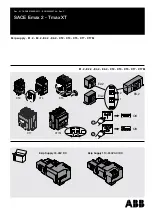
28
9-1 Electrical Operation
Electrical checking consists of electrical breaker
operation primary and seconary wiring high-po-
tential testing (if required), primary circuit
reistance (if required), PowerVac interrupter high-
potential testing, and insulation resistance to
ground.
To check the electrical operation with the breaker
removed from the cubicle, attach a secondary
test coupler to the circuit breaker connector and
the other end to the secondary coupler mounted
in the cubicle. Check the control voltage on the
nameplate and close and open the breaker sev-
eral times.
CAUTION:
REPEATED OPERATIONS AT A RATE
EXCEEDING TWO PER MINUTE MAY CAUSE
CHARGING MOTOR OVERHEATING AND FAILURE.
Leave the circuit breaker in an open and spring
discharged condition after checks are complete
and before inserting the circuit breaker into a
metal-clad unit. Reinstall the front cover if it
has been removed.
9-2 High-Potential Test
If hi-potential tests to check the integrity of the
insulation are required, the AC hi-potential test
described below is strongly recommended. DC
high-potential testing is not recommended. The
following procedure must be adhered to.
CAUTION:
IF DC HIGH-POTENTIAL TESTING IS
REQUIRED, THE DC HIGH POTENTIAL MACHINE
MUST NOT PRODUCE PEAK VOLTAGES EXCEED-
ING 50 KV.
NOTE:
ALWAYS RECHECK WITH AN AC TEST
SET, IF INITIAL RESULTS ARE QUESTIONABLE.
Primary Circuit
The breaker should be AC hi-potted in the closed
breaker mode to verify the insulation system.
An AC hi-pot machine capable of producing the
test voltages shown below may be used to hi-
pot the breaker phase to phase and phase to
ground.
BREAKER VOLTAGE
TEST VOLTAGE
4.16 kV
14 kV
CAUTION:
DISCONNECT THE SURGE SUPPRES-
SORS BEFORE HI-POTTING THE CIRCUIT BREAKER.
The machine should be connected with its out-
put potential at zero and the voltage increased
at 500 vps to the test voltage and that voltage
maintained for 60 seconds. The voltage should
then be returned to zero and the hi-pot machine
removed from the circuit. Do not exceed the
test voltage indicated for the applicable breaker
voltage rating.
If the test should experience a failure, STOP,
turn off the test set and discharge the breaker
circuit.
1. Check the test setup and leads for con-
nection errors.
2. Wipe down the breaker to remove any
moisture, dust and contamination.
3. Retest the breaker at the proper test volt-
age.
Secondary Circuit
Prior to hi-potting the breaker secondary circuit,
disconnect the motor leads and thread a wire
connecting all secondary coupler pins. Con-
nect the hi-pot machine from this wire to ground.
Increase the voltage to 1125 volts (rms) 60 Hz
and maintain for 60 seconds. Reduce the volt-
age to zero and remove the hi-pot machine con-
nections from the circuit. Remove the wire con-
necting the secondary coupler pins and recon-
nect the motor leads.
9-3 Primary Circuit Resistance
A resistance check of the primary circuit may
be made with the breaker closed. Use a low
resistance measuring instrument which mea-
sures micro-ohms. The 100 ampere reading
should be less than 40 micro-ohms when con-
nected.
9-4 Vacuum Interrupter Integrity Test
NOTE:
USE OF A DC HI-POT IS NOT RECOMMENDED,
BUT CAN BE USED FOR QUICK FIELD CHECKS ONLY.
ALWAYS RECHECK WITH AN AC TESTER IF INITIAL RE-
SULTS ARE QUESTIONABLE. PRIOR TO PERFORMING
ANY VACUUM INTERRUPTER INTEGRITY TEST, THE
OUTSIDE (EXTERNAL SURFACE) OF THE VACUUM IN-
TERRUPTERS SHOULD BE WIPED CLEAN OF ANY
CONTANMINATES WITH A NON-LINTING CLOTH OR
INDUSTRIAL TYPE WIPER. THIS IS CRITICAL: THE EN-
TIRE EXTERNAL SURFACE IS TO BE COMPLETELY FREE
OF ALL DIRT, DEBRIS, DUST, OIL, ETC.
CAUTION:
X-RADIATION WILL BE PRODUCED IF AN
ABNORMALLY HIGH VOLTAGE IS APPLIED ACROSS A
PAIR OF ELECTRODES IN A VACUUM. X-RADIATION
WILL INCREASE AS VOLTAGE INCREASES AND/OR
AS CONTACT SEPARATION DECREASES. ONLY TEST
A CORRECTLY-ADJUSTED CIRCUIT BREAKER.
DURING A HIGH-POTENTIAL OR A VACUUM INTEG-
RITY TEST, ANY X-RADIATION WHICH MAY BE PRO-
DUCED WILL NOT BE HAZARDOUS AT A DISTANCE
SAFE FOR HIGH-POTENTIAL TESTING, IF THE TEST IS
CONDUCTED AT THE REC-OMMENDED VOLTAGE
AND WITH THE NORMAL OPEN CIRCUIT BREAKER GAP.
DO NOT APPLY VOLTAGE THAT IS HIGHER THAN
THE RECOMMENDED VALUE OR USE CONTACT
SEPARATION THAT IS LESS THAN THE RECOM-
MENDED OPEN-POSITION BREAKER CONTACT
GAP.
PowerVac
®
5kV Vertical Lift
Chapter 9. Electrical Checks
















































